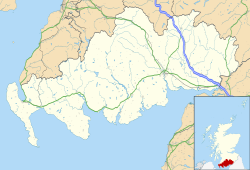| Holywood | |
|---|---|
 Twelve Apostles stone circle | |
Location within Dumfries and Galloway | |
| OS grid reference | NX950797 |
| Council area | |
| Lieutenancy area | |
| Country | Scotland |
| Sovereign state | United Kingdom |
| Post town | DUMFRIES |
| Postcode district | DG2 |
| Police | Scotland |
| Fire | Scottish |
| Ambulance | Scottish |
| UK Parliament | |
| Scottish Parliament | |
Holywood is a village and civil parish in the historical county of Dumfriesshire in Dumfries and Galloway, Scotland. The village of Holywood was developed in the mid twentieth century. [1] In 1949 eighteen houses were built by the county council and followed shortly after by another 38. [2]
Holywood was the site of a Premonstratensian abbey which was established in 1225 and dissolved in 1609. [3] [4] The abbey was dismantled and used to build the parish church in 1778. [3] No remains are now visible. [3]
The site of Holywood Abbey was previously called Dercongal , 'Congal's oak-copse'. [5] The name Holywood refers to this oak-copse. [5] The saint commemorated in this name may be Convallus, disciple of Saint Mungo. [5] However, there are a number of other saints to whom the dedication could apply. [6] The surrounding landscape has several prehistoric monuments, including two cursuses and the Twelve Apostles stone circle, [7] which suggests a continuity of sacred or administrative tradition in the area. [8]
The parish previously had three schools: Speddoch, Steilston and Holywood, near the village. [9] The current school building was built in 1967. [1] Its catchment includes the Woodlands area of Dumfries and part of the catchment of Auldgirth Primary School, which closed in 2000. [10]
Holywood railway station opened as Killylung in 1849 but was renamed Holywood within a year and closed in 1949.
